Check out my custom vibration dampener
Tennis Racquet Grip Sizes
How-To Guide + Chart & Visuals
If you’re about to buy a new tennis racquet or are considering changing racquets, evaluating and selecting the appropriate grip size is crucial for optimal performance and comfort.
Although grip size ultimately boils down to personal preference and feel, selecting the wrong size grip can have painful repercussions that you can easily avoid through a little due diligence.
In this guide, I’ll explain how tennis racquet grips are measured, the benefits of finding the right size, and how to determine the perfect fit for your hand. I’ll also share tips for selecting the best size, what the pros use, and how to change a racquet’s grip size.
Article Contents
Click below to jump to a section
Tap below to jump to a section
Grip Size Video
How Grip Sizes Are Measured
Why Grip Size Matters
Determine Your Grip Size
Kids Grip Sizes by Height
Demoing Grip Sizes
Pro ATP & WTA Grip Sizes
Changing a Grip’s Size
Wrapping Up
New to TennisCompanion?
Create a free account and explore my latest videos below
Tennis Racquet Grip Sizes [Video]
If you’re a visual learner, you might enjoy my video on selecting the perfect size grip for your racquet, which covers everything you need to make the best choice for your game.
Here are timestamps for each section I cover so you can quickly jump around to find the information you need.
0:16 – Why Grip Size is Important
0:56 – Measurement & Sizes
1:23 – Grip Size Chart
1:28 – Finding Your Grip Size
1:34 – Method #1
2:06 – Method #2
2:41 – Changing Grip Sizes
3:07 – Grip Sizes for Kids
3:25 – Kids Racquet Size Chart
If you’re a parent looking for the right grip size for your child, I’d encourage you to check my complete guide on kid’s racquet sizing. In the article, I cover everything you need to know and provide recommendations for high-quality, affordable kids’ racquets.
Alternatively, you can jump straight to the section of this article where I discuss children’s grip sizes by clicking here.
How Grip Sizes Are Measured
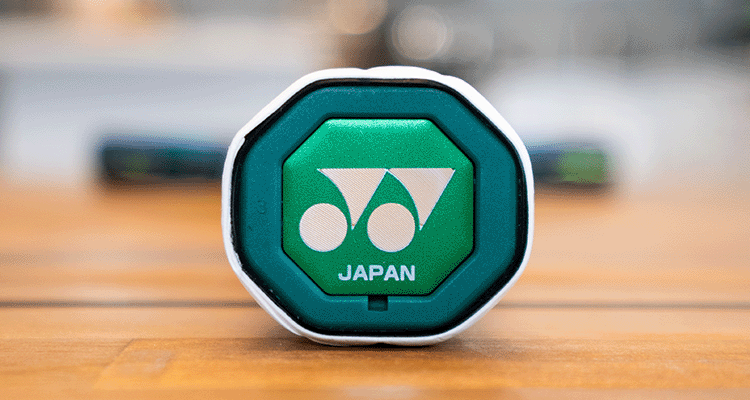
A tennis racquet’s grip size measures the circumference or distance around the handle, ranging from 4 inches to 4 3/4 inches.
There are eight available grip sizes within that range, which start at 3 7/8 inches (9.8 cm) or a size double zero and increase by 1/8 inch for each size up to 4 3/4 inches (12.1 cm) for a size six.
Tennis Racquet Grip Size Chart
The size of a racquet’s grip may be expressed differently based on your country, so I’ve included a table with conversions to the most common measurements you’ll find.
| Size | Type | Inches | Centimeters | Millimeters |
| 00* | Kids | 3 7/8 | 9.8 | 98 |
| 0 | Kids / Adults | 4 | 10.2 | 102 |
| 1 | Adults | 4 1/8 | 10.5 | 105 |
| 2 | Adults | 4 1/4 | 10.8 | 108 |
| 3 | Adults | 4 3/8 | 11.1 | 111 |
| 4 | Adults | 4 1/2 | 11.4 | 114 |
| 5 | Adults | 4 5/8 | 11.8 | 118 |
| 6* | Adults | 4 3/4 | 12.1 | 121 |
*Double zero is a newer size reserved for children’s racquets, but zero is the most common size racquet grip for younger players.
**Size six is a thing of the past, but I’ve included it because players might stumble upon older racquets with this size.
It’s worth noting that not all racquets are available in every grip size. For example, most kids’ or junior tennis racquets are only available in size zero or one through five for adult racquets.
In rarer cases, such as with some Babolat frames, you’ll find lightweight adult-size racquets with size zero grips.
Available Grip Sizes from Top Brands
Thankfully, grip sizes are standardized, so all brands use the same measurements and sizing for their racquet handles.
However, the sizing a brand makes available for its racquets varies and may change based on the specific model, so every racquet they offer is not guaranteed to have all these sizes.
| Brand | Available Grip Sizes |
| Angel | 1-5 |
| Babolat | 0-5 |
| Dunlop | 0-4 |
| Head | 0-5 |
| Prince | 0-4 |
| ProKennex | 0-5 |
| Tecnifibre | 1-4 |
| Volkl | 0-5 |
| Wilson | 0-4 |
| Yonex | 0-5 |
Here’s an example where Babolat has limited the available selection of grip sizes based on the typical player profile that would use each of the following racquets.
| Racquet | Available Grip Sizes |
| Babolat Pure Aero | 1, 2, 3, 4, 5 |
| Babolat Pure Aero Lite | 0, 1, 2, 3 |
| Babolat Pure Aero Junior 26 | 00 |
Finding Your Racquet’s Grip Size
Usually, you’ll find the size of a tennis racquet’s grip listed on its butt cap at the very bottom of the handle. This has become the standard location for displaying grip size for most brands.
However, some brands will only list the number corresponding to the size, while others may display the number and measurement.
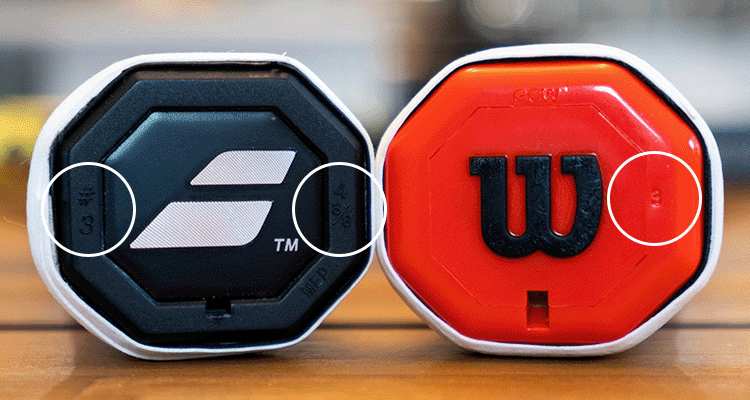
Furthermore, the grip size may be printed in a different location, such as near the racquet’s throat or shaft.
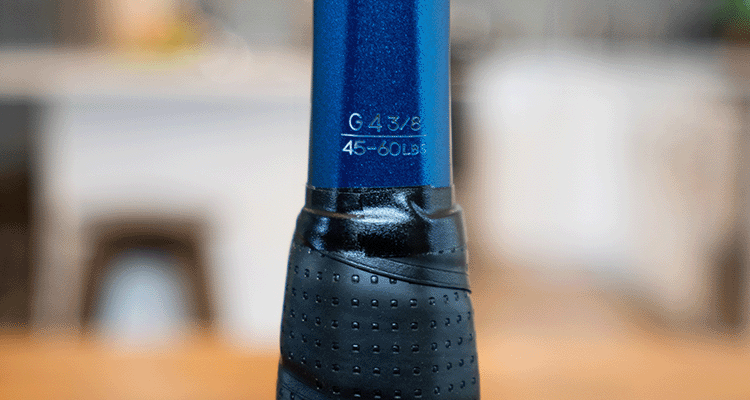
In other cases, you may find it printed under the butt cap’s trap door.
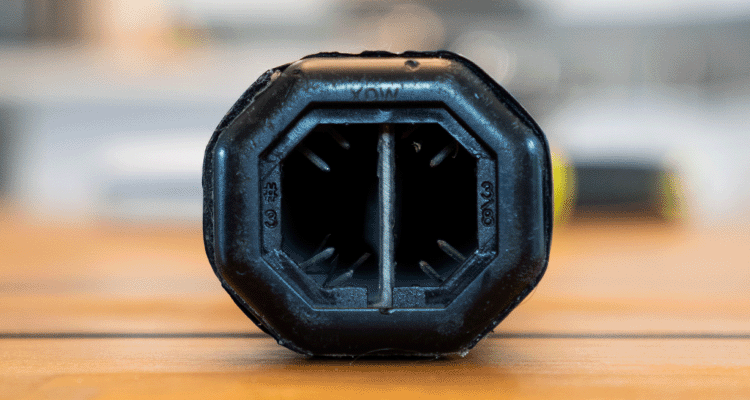
Generally, carefully inspecting the frame from top to bottom will uncover the grip size.
However, some manufacturers place stickers on the racquet, making it more challenging to identify a racquet’s size once peeled off.

As a last resort, you can measure the circumference of your racquet’s handle with a flexible measuring tape.
Why Does Grip Size Matter?
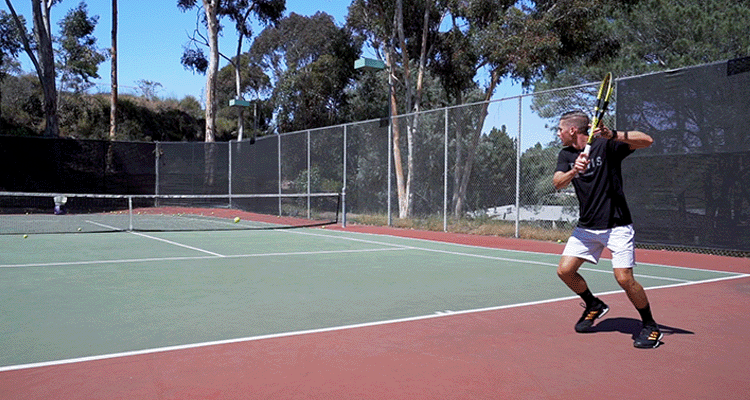
An appropriately sized grip will provide optimal comfort and feel while helping prevent injury.
A grip that’s too small may twist or rotate within your hand when striking the ball, leading to painful blisters and unnecessary strain on your arm as you overcompensate by holding the grip too firm. Over time, this can contribute to injuries such as tennis elbow.
Furthermore, a grip that is too small can also slip from your hand, especially when sweating heavily.
On the other hand, a grip that’s too large can be challenging to hold, putting unnecessary stress on your hand, wrist, and arm.
Moreover, a large grip can be challenging to manage when you need to change grips quickly or when you’re looking to snap your wrist when hitting a forehand, serving, or hitting an overhead because it restricts movement in your wrist.
The key is to find a grip size that feels comfortable, prevents undue stress on your body, and allows a full range of motion.
Grip Size for Maximum Spin
Many players argue they can generate more topspin with smaller grip sizes, which they feel provide more control and a snappier release when striking the ball.
Rafael Nadal is well-known for using a smaller size two grip, which he argues feels right and allows him to generate the most spin. Recognizing that he hits with some of the highest RPMs on the ATP tour, it’s noteworthy and worth considering.
Perhaps most importantly, it underscores that the “right” fit for a grip size is the one that feels best and allows you to perform at a high level, which you can only learn by experimenting.
How to Determine Your Grip Size
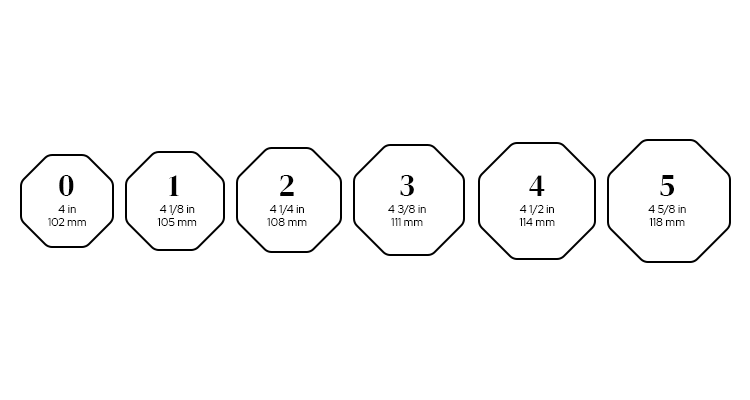
Measuring Your Grip Size
Two standard methods help identify the ideal grip size for a player. I typically recommend using both to help get the best fit.
However, before getting started, keep in mind that these methods intend to get you in the right ballpark for your grip size.
Unfortunately, both are imperfect, but they should help get you close to the correct measurement, which you can refine by testing different grip sizes in person to achieve the optimal fit.
Method #1: With a Ruler
First, if you have one handy, grab a ruler or measuring tape. Next, look at your dominant hand, and you’ll notice a bunch of lines or creases running through your palm.
If you look closely, you should see two large or more prominent lines in the middle of your palm, one on top and one on the bottom, running horizontally from one side to the other.
Grab your ruler or measuring tape and line it up vertically with your ring finger so that the bottom of the ruler lines up with the top horizontal line in your palm and measure to the tip of your ring finger.

You should find that the measurement falls between 4 inches and 4 3/4 inches. As you can see above, mine measures 4 3/8 inches or a size three grip.
Helpful Tip
This method works great if you’re ordering online and you don’t have access to test out multiple grip sizes in person. However, if you do order online and you’re between sizes, I’d encourage you to go with the smaller size as it’s much easier to increase the size of a grip than decrease it.
Please note that the creases in everyone’s hands aren’t identical and vary from person to person. With that in mind, if the lines in your hand don’t look like mine, that’s fine. You likely have at least one prominent crease that runs close to the edge of your hand, which should be sufficient for taking a measurement.
However, if you measure your hand and don’t come up with a logical size for your grip, don’t get discouraged. Instead, skip the ruler approach and move on to the following method.
Method #2: Test Grips in Person
Another method to find the right grip size is to try multiple sizes in person and reference the gap between your fingers and your palm when holding the racquet.
First, grab a racquet handle with your dominant hand and note the grip size. Then, place your index finger within the gap between your fingers and palm with your other hand. You’re looking for a grip where that space roughly equals your index finger’s width.
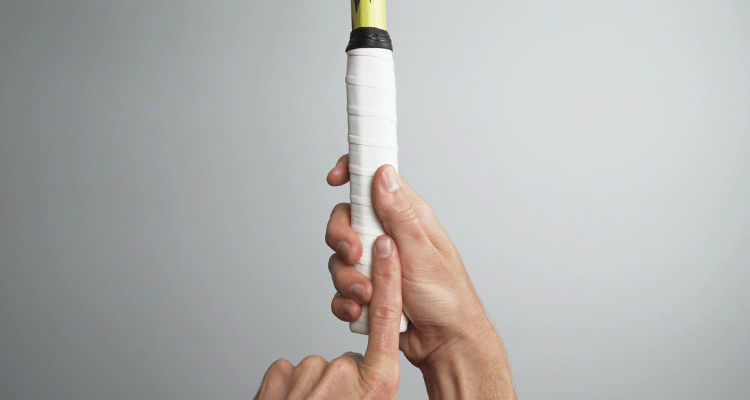
Once you find the grip size that roughly matches up, I’d recommend trying one size above and below to compare and see what feels best. The racquet’s handle should feel comfortable yet secure.
Many players will fall between sizes, which is common. If that’s you, I’d encourage you to go for the smaller size because it’s easier to increase your grip size than decrease it.
For example, adding an inexpensive overgrip will increase your grip size by 1/16 of an inch or a half size. Similarly, a local racquet technician can add a heat shrink sleeve to the grip to increase the size by 1/8 of an inch for a full-size increase.
However, apart from swapping out the base grip that came with the racquet or removing it altogether, it is difficult and, in some cases, impossible to drop the size of a grip.
Men’s vs. Women’s Grip Sizes
Tennis racquet grip sizes are universal, not gender-specific.
Although it’s common for women’s hands to be smaller than men’s, the sizes or measurements don’t change for genders.
Average or Most Common Size Grip
A size 3 or 4 3/8 grip is the most common, and you’ll find many crossover between men and women at this size.
Most women will play with a grip size that’s a size 1, 2, or 3. Men, on the other hand, will typically have a size 3, 4, or 5.
Although average or standard grip sizes are helpful as a point of reference, many players fall outside these ranges, so it pays to do your homework.
4 3/8 vs. 4 1/2 Grip Sizes
Many men looking for tennis racquets will choose between a size 3 (4 3/8 in) and a size 4 (4 1/2 in) grip.
If you’re on the fence between the two, I’d encourage you to go with 4 3/8 because it’s much easier to build up a grip than reduce it, and the difference between the two is only 1/8 inch or 3.2 mm.
You may also find that adding a single overgrip to a size 4 3/8 grip for a half size or 1/16 inch increase gives you the perfect fit, as it does for me.
Kids Grip Sizes by Height
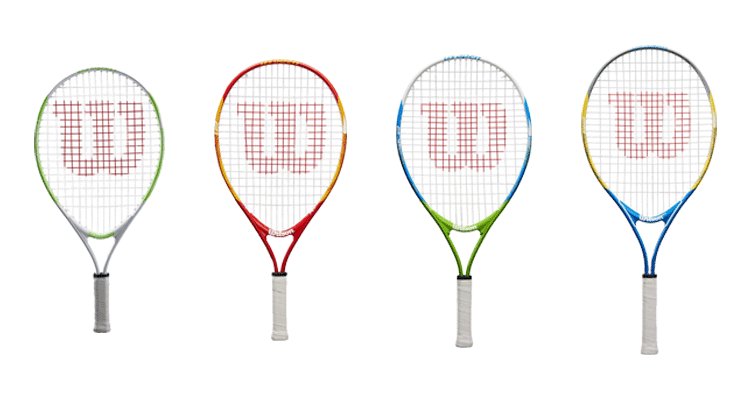
For kids, there are typically fewer grip size options than adults. Most will usually fall at size zero, 4 inches or less, which depends on the manufacturer.
However, instead of finding the right grip size, parents will want to focus on the racquet’s length, which generally corresponds with their child’s height. The following chart outlines those sizes.
Inches
| Age | Height | Racquet |
| 4 or younger | 40 in or less | 19 in |
| 4-5 years | 40-44 in | 21 in |
| 6-8 years | 45-49 in | 23 in |
| 9-10 years | 50-55 in | 25 in |
| 10 or older | 55+ in | 26 in |
Centimeters
| Age | Height | Racquet |
| 4 or younger | 102 cm or less | 48.3 cm |
| 4-5 years | 102-113 cm | 53.3 cm |
| 6-8 years | 114-126 cm | 58.4 cm |
| 9-10 years | 127-140 cm | 63.5 cm |
| 10 or older | 140+ cm | 66.0 cm |
If you buy a tennis racquet that your child can comfortably handle at the right length, the grip size should work out.
However, I wouldn’t be overly concerned, even if the grip is slightly large. First off, your child will grow into it quickly, and second, most young kids won’t play aggressively or long enough with that grip size to harm their hand, wrist, or arm.
Demoing Racquets for the Perfect Fit

Although I hope the methods we’ve reviewed in this article help point you in the right direction toward your ideal grip size, there’s no substitute for testing out different grip sizes while playing.
Therefore, I highly recommend players get their hands on a few different tennis racquets with varying grip sizes before deciding and buying a tennis racquet.
You can take advantage of one of many available racquet demo programs to test different-sized grips. Here are a few options to consider for tracking down demo racquets:
- Local tennis shop
- Racquet club’s pro shop
- Online retailers
Once you’ve settled on a specific model tennis racquet, demoing the same racquet with different size grips is ideal. That’s because changing between different racquets with varying grip sizes will make it challenging to gauge how feel changes from one size to the next.
However, if you can’t track down multiple grip sizes for the same racquet, it’s still better to test different models with varying grip sizes than not at all.
In my experience, local tennis and pro shops will carry a single model in one or two standard grip sizes, while online retailers will have a broader range of grip sizes available for each racquet.
As a last resort, use the methods outlined in this guide to approximate your grip size, and if you’re on the fence, order a size down. From there, you can build up your grip for the perfect feel.
Pro ATP & WTA Grip Sizes

As a point of reference, you might find it helpful or interesting to know what some of the world’s top players use for their grip size.
One thing you’re likely to spot quickly is that most of the players listed are using the average size 3 or 4 3/8 inch grip.
ATP Grip Sizes
| Player | Grip Size |
| Rafael Nadal | 4 1/4 |
| Roger Federer | 4 3/8 |
| Novak Djokovic | 4 3/8 |
| Andy Murray | 4 3/8 |
| Dominic Thiem | 4 1/4 |
| Alexander Zverev | 4 3/8 |
| Stefanos Tsitsipas | 4 3/8 |
| Daniil Medvedev | 4 3/8 |
| Nick Kyrgios | 4 3/8 |
| Grigor Dimitrov | 4 3/8 |
WTA Grip Sizes
| Player | Grip Size |
| Serena Williams | 4 5/8 |
| Venus Williams | 4 5/8 |
| Maria Sharapova | 4 3/8 |
| Caroline Wozniacki | 4 3/8 |
| Sloane Stephens | 4 3/8 |
Although players sometimes change racquets, most rarely change their grip size, which remains constant throughout their career.
Changing a Grip’s Size

Whether you’re playing it save and ordering down a grip size or looking to change the size of your existing grip, it’s helpful to understand how to increase or decrease your grip size.
Increasing Grip Size
Generally, it’s easier to build up a grip and make it larger, so I recommend players order down a size if they’re between sizes or on the fence between two sizes, i.e., 4 3/8 vs. 4 1/2.
The quickest and easiest way to build up a grip is to add an inexpensive overgrip on top of the grip your racquet’s existing grip. Doing so will add 1/16 of an inch for a half-size increase. Adding two will increase your grip size by 1/8 of an inch, the equivalent of a full-size increase.
Helpful Tip
The handle of a tennis racquet has eight sides or bevels, which prevent the racquet from twisting in your hand, help you maintain a solid grasp, and allow you to identify various types of grips quickly. Keep in mind that as you add overgrips, the bevels will become less pronounced.
Alternatively, you could replace the racquet’s existing grip with a thicker replacement grip for some added thickness. Swapping out a replacement grip is a bit trickier, but it’s still straightforward.
Finally, for a more permanent solution, you can remove your racquet’s grip and add a plastic heat shrink sleeve, available in half sizes or 1/16 of an inch and full sizes or 1/8 of an inch.
One of the benefits of heat shrink sleeves is they allow you to increase the size of your handle while maintaining clean bevel edges, which you lose slightly with each overgrip you add.
Decreasing Grip Size
If you accidentally buy a racquet with a grip size that’s too large or want to reduce the grip size on your racquet, you have a few options to consider.
Typically, the first step I’d encourage you to take is to replace the existing grip on the racquet with a thinner one. Most tennis racquets come with a thicker replacement grip for added comfort. However, thinner grips are available to reduce a grip’s size and change a racquet’s feel.
Some players prefer a lower profile grip for added feel, while others enjoy a thicker grip for extra comfort. The main drawback to a thinner grip is that you may end up with more shock and vibration, i.e., less comfort. Nevertheless, give it a try to see how it feels for you.
If replacing the grip isn’t practical because you need to drop the grip size further or doing so would reduce comfort too far, then a racquet technician may be able to help you sand down your grip depending on your grip’s material.
It’s also worth considering the cost of having someone customize your tennis racquet. You’ll often be better off buying a new racquet instead of absorbing the cost of customizing yours.
Wrapping Up
Although finding the right grip size takes a bit of trial and error, it pays to get something that feels comfortable and allows you to perform your best. Thankfully, you’ll only need to go through the process of identifying the correct size grip once. Then, after finding the size that works well, you’ll know what to order for all future racquet purchases.
As a parent, you don’t need to worry too much about grip sizes for your kids until they transition to a full-size 27-inch tennis racquet with a greater variety of grip sizes. You’ll also likely need to remeasure for the appropriate grip size as they grow.
Now that you know how to select the correct size grip, head on over and check out our list of the top 20+ racquets for 2024 to find a racquet you’ll love. Of course, if you have any questions on this topic, let us know in the comments below.
Play Better Tennis
Improve your game alongside our community of tennis players
Why join?
Discussion Boards
Join the conversation with other members of the community.
5 Point Friday
Read our weekly recap of the 5 most interesting things we dig up in tennis.
Trackbacks & Pingbacks
Leave a Reply
Want to join the discussion?Feel free to contribute!



I bought my 14 daughter a new tennis racquet for Christmas. I had no idea about size. The size I got is 4 1/2. This is her first year playing. Is that size to big? I would hate to take it back.
Hi Kevin,
Happy Holidays! Unfortunately, yes, that grip size will be too large for a 14-year-old, sorry to be the bearer of bad news.
If you didn’t stumble upon my guide for kids racquets, I’d encourage you to check it out – it should have everything you need to make sure the next one you buy is a perfect fit.
All the best,
Jon
Hello,
Good article! I measured my hand as you indicated but mine was less that 4”, 3 3/4” to be exact. What grid size should I choose? I am adult. Thanks!
Hi Pauline,
Thanks for stopping by and asking a great question!
Your scenario isn’t all that uncommon, so I’m glad you asked. Players in your situation will want to use a #0 or 4-inch grip size.
If you find this grip size challenging to handle, you have two options. First, you can try replacing the grip that came with your racquet for a thinner option – here’s an article with some recommendations:
The downside of swapping out your grip with a thinner option is that it might lack a bit of comfort, so there’s going to be a trade-off.
Alternatively, you can check with your local tennis retailer and have them look at your racquet to see if they can reduce the handle’s size. Unfortunately, it’s less common that this is possible with the materials used for handles these days, but it’s worth a shot.
Hopefully, this helps point you in the right direction.
All the best,
Jon
I’m looking for some clarity on measurement with a ruler. I am getting back into the game – played for 15 years with a 4 5/8 (with numerous shoulder and elbow issues). When I measure from my ring finger to the middle of my top line, I’m 4 inches. To the middle line, I’m 4 1/2. So, per your rec, I should look at a 4 (or 4 1/4) and then add wraps if needed?
Blows my mind to think that I had be playing with a racquet up to 5 sizes too big?!?! Wonder if this contributed to my long standing elbow issues…
I’ve also seen several sites say to measure to the middle line of the palm (vs. the top). Why the discrepancy?
Hi William,
The discrepancy you’re having likely has to do with the differences in the lines of your hand, which will be different for some players, and why some websites suggest varying lines in a player’s hand. As I mentioned, this is, unfortunately, why these methods are imperfect.
Considering that you used to play with a size five, you’ll likely need a bigger grip size than what the measurement tells you, but perhaps not quite as big. Years ago, playing with a larger grip was more common, but that’s evolved along with the game.
That said, did you try the second method, i.e., holding the handle for your old racquet and placing your index finger between the gap of your fingers and the palm of the hand holding your racquet?
If there’s a huge gap, you’re likely using a grip that’s too large, so you can try holding a few different grip sizes until your index finger roughly fills that gap. However, it’s crucial the size you select feels good in your hand as well, and in a perfect world, I’d want you to demo the size you’re landing on to ensure that it doesn’t cause you any discomfort.
I wouldn’t speculate what caused your shoulder and elbow issues, but dialing in the correct size grip should help as you return to the game. However, as you select a new racquet, I’d encourage you to consider your frame’s stiffness, weight, and the type of strings you’re using as factors.
Here are some resources to help:
All the best,
Jon
Hi,
I measure from top of my ring finger to first line 130mm. I used to play with size 4 until i developed pain in small bones of the palm. After much pain and bad tennis i finally discovered the cause was too small grip size.
So i built up the grip size of one of my rackets to 7 (124mm) and the other one to size 9 (131mm). Playing with the smaller one still makes my palm hurt after a while. The larger one is pain free (and passes the finger test perfectly) but is kind of clumsy.
I plan on buying a new racket soon but the standard grip sizes end at L5. I have not seen anything with size 6 available anywhere. Not to mention 7 or 9.
Am i really stuck having to build up grips with heatshrink tubes?
That is not a good solution as they add weight and mess with the balance — my size 7 weighs 343g and the 9 is 370g. That’s a bit much to handle.
I’m not a giant by the way (below two meters).
Hi James,
That’s a pretty big jump from a size four to a seven, but if it works and feels comfortable, I woudn’t try to tell you it’s wrong.
Have you tried the second method I outlined in the article? If not, I’d encourage you to try that with your existing racquets. Also, it’s pretty inexpensive to demo racquets from online retailers, so you could do well with demoing a handful of grip sizes to see what works best. Ultimately, it boils down to personal preference – the methods outlined are intended to serve as a guide and will work better for some than others.
Heat shrink sleeves are the most economical approach to changing the size of a racquet’s handle outside of adding an overgrip or using a thicker replacement grip. Some specialized craftsmen like Roman Prokes will completely rebuild a grip for a price. Unfortunately, regardless of the method, you add material and weight, changing the specs.
A talented racquet technician can make further changes to other parts of the racquet to help maintain specs with the added weight in the handle. However, you’re getting into some pretty serious customization that, for most players, is cost-prohibitive.
All the best,
Jon
Just getting into tennis (4 lessons so far). I measure at 5 3/8 using the above method. Puts me way out of range. Options?
Hi TJ,
Unfortunately, that’ll happen for some players. Have you tried the second method outlined in the article? If not, give it a go.
What size grip does the racquet you use for your lessons have? That should serve as an excellent reference point, which, along with demoing a handful of grip sizes, should help you narrow things down.
Also, don’t be afraid to ask your instructor, who can help provide on-the-spot guidance combined with your direct experience.
All the best,
Jon
For the grip measurement you say “bottom of the ruler lines up with the top horizontal line in your palm” but almost every other guide I can see online says the bottom horizontal line. Could you confirm? Thanks!
Hi David,
I can’t speak for other websites, but the top horizontal crease has consistently worked for most players I’ve helped over the years.
That said, the creases in everyone’s hands aren’t identical, which is why there is a discrepancy with this method. I’ve worked with plenty of players where this method doesn’t work, so we’ll move to the second method combined with demoing a handful of racquets to gauge feel.
All the best,
Jon
Hi there, i measured my hand-ring finger length and am 3.8inches. What size grip do you recommend i buy in that case? Do i buy a kid’s racket?
Hi Jean,
If you’re an adult, you’ll definitely want to purchase a full-size adult racquet :) The methods I outline are imperfect, so if you’re getting a measurement that seems off, as with yours, I’d encourage you to try method #2 and demo a few racquets to gain first-hand experience for their feel to make a decision.
All the best,
Jon
Hi, I have noticed that some brand are reducing available grip sixes. Babolat are only offering grip size 2, 3 and 4 for the new Pure Aero 98. This while the comparable older version Pure Aero VS and also the Tour were available also in 1. Do you know why?
I find it surprising as 1 is not that small and in particular as there is a current trend that many are going down in sizes.
Hi Kamila,
Babolat doesn’t offer the same size grips for all of their racquets, but they sell the Pure Aero 98 in a size one. My best guess is that they were out of stock when you looked. Some websites will remove the option entirely, making it appear unavailable. I’d check a handful of retailers to see what you can dig up. Good luck!
All the best,
Jon